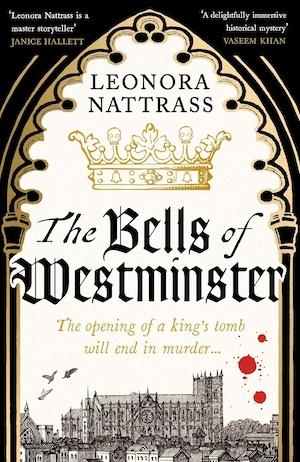
Leonora Nattrass quickly became a favourite in historical crime fiction with her Laurence Jago series which began with Black Drop and involves the espionage, politics and criminality of 1790s England and its empire. Literary tales with a light touch, her books have similar appeal to those of William Boyd. It’s a style she has retained in this new standalone adventure set two decades earlier than the Jago stories. It’s 1774 and we’re in and out of the halls at Westminster Abbey and the surrounding area.
This time the central character is Miss Susan Bell, daughter of the Dean of the Abbey, who supports her widowed father in his work. He is a decent man but much preoccupied with the daily life of the church and not entirely suited in character to raising a young woman. Susan has grown up within the rather dull confines of church buildings and grounds. Instantly, we can see she is a bright young woman, curious about the world that she is now just beginning to experience as an adult, in that respect this is a charming coming-of-age story.
The problem for the energetic Susan is expectation – the Georgian strictures that determine how a woman should behave, the role society has defined for her gender, the rules of social mixing and behaviour in company. There is an assumption that she must make a good marriage, while also tending to the needs of her father, helping with the women’s groups at the Abbey and fending off aged suitors.
When a group of men from the Society of Antiquarians arrive to investigate the tomb of Edward Longshanks, Susan’s curiosity aroused. Edward I was the 13th century King of England, the hammer of the Scots, or the murderer of William Wallace and thief of the Stone of Scone depending from the Scots’ perspective. The men of science are here at the behest of George III but soon ghostly apparitions of ill portent appear.
When the body of the entombed king goes missing and one of the antiquarians is killed everyone is embroiled in the murder mystery. It’s one Susan can’t help but throw herself into. Her father’s position is threatened by all this controversy and the potential scandal is too much to contemplate. Is one the visitors a killer or does Westminster Abbey itself have a murderer lurking in the shadows?
The murder investigation is richly Golden Age while the view of the science of the time and the sense of discovery are equally intriguing. Susan’s quest is fascinating, weaving as she does between the things she is supposed to see and do and where her instinct takes her.
Nattress’s storytelling is playful and engaging as we witness 18th century archaeological investigation juxtaposed with a murder mystery. Susan’s story grates a little with our modern sensibilities but she is brave and forthright and her butting up against contemporary notions of a woman’s role is satisfying. Some lovers of the Laurence Jago books may bemoan the break in that series but have no fear this is a worthy interjection. This is fun and intelligent and a pleasure to read.
What’s most enjoyable about this novel is the easy way Nattrass has of portraying the past in all its complexity, the differences in culture and thinking, the mindset of men of science – elements that comes from deep research and empathy. We talk a lot about agency in fiction but for all her spirit Susan acts within the boundaries of the possible, with a little authorly speculation. She match for any man and a memorable character. One of the books of the year I will look back on most fondly.
Viper Books
Print/Kindle/iBook
£6.99
CFL Rating: 5 Stars









